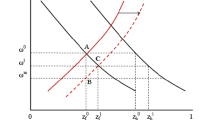Abstract
The Factor Price Equalization theorem implies that freer trade would narrow the gap in returns to similar productive factors across countries over time. To determine the empirical relevance of this implication, data for 11 industries in 14 countries over the period 1970–1985 are investigated. Moreover, the paper examines the data for seven industries in the nontrade sector. Regression analyses suggest that the industry-level wages across countries are significantly influenced by the relative dispersion of production techniques at the industry level and, to a lesser extent, by international trade. The estimation of a wage model indicates that the diffusion of technology may have also played a role in the apparent convergence of wages. The findings of this paper suggest that FPE is capable of explaining the cross-country variation in returns to productive factors.
Similar content being viewed by others
References
Abramovitz, Moses (1986) “Catching Up, Forging Ahead, and Falling Behind,”Journal of Economic History 46, 385–406.
Alston, Julian M. and Paul R. Johnson (1988) “Factor Price Equalization among International Farmalnd Markets,”Australian Journal of Agricultural Economics 32, 142–152.
Barro, Robert J. (1991) “Economic Growth in a Cross Section of Countries,”Quarterly Journal of Economics vol. 106, 407–443.
Baumol, William J. (1986) “Productivity Growth, Convergence, and Welfare: What the Long-Run Data Show,”American Economic Review 76, 1072–1085.
Bhagwati, Jagdish (1964) “The Pure Theory of International Trade: A Survey,”The Economic Journal 74, 1–84.
Dollar, David and Edward N. Wolff (1988) “Convergence of Labor Productivity Among Advanced Economies, 1963–1982,”Review of Economics and Statistics 70, 549–558.
Dollar, David, Edward N. Wolff, and William J. Baumol (1988) “The Factor-Price Equalization Model and Industry Labor Productivity: An Empirical Test Across Countries.” In Robert C. Feenstra (ed.),Empirical Methods for International Trade. Cambridge: MIT Press, p. 23–47.
Dowrick, Steve and Duc-Tho Nguyen (1989) “OECD Comparative Economic Growth, 1950–1985: Catch-up and Convergence,”American Economic Review 79, 1010–1030.
Fair, Ray C. (1970) “The Estimation of Simultaneous Equation Models with Endogeneous Variables and First Order Serially Correlated Errors,”Econometrica vol. 38, 507–516.
Ethier, Wilfred J. (1988)Modern International Economics. 2nd ed. New York: W.W. Norton.
Edwards, Sebastian (1988) “Openness, Outward Orientation, Trade Liberalization and Economic Performance in Developing Countries,” NBER Working Paper No. 2908, March.
Floystad, Gunnar (1974) “Factor-Price Equalization in Theory and Practice,”Weltwirschaftliches Archive 9, 554–578.
Gremmen, Hans J. (1985) “Testing the Factor Price Equalization Theorem in the EC: An Alternative Approach,”Journal of Common Market Studies 23, 277–286.
Jones, Ronald W. (1988) “Heckscher-Ohlin Trade Theory.” In John Eatwell, Murray Milgate, and Peter Newman (eds.),The New Palgrave A Dictionary of Economics, vol. 2. London: Macmillan Press Limited, p. 620–627.
Kotlikoff, Laurence J. and Edward E. Learner (1987) “Empirical Tests of Alternative Models of International Growth.” In Colin I. Bradford and William H. Branson (eds.),Trade and Structural Change in Pacific Asia. NBER Conference Report, Chicago: University of Chicago Press, p. 227–269.
Krueger, Anne O. (1968) “Factor Endowments and Per Capita Income Differences Among Countries,”Economic Journal, vol. 78, 641–659.
Learner, Edward E. (1992) “Testing Trade Theory,” NBER Working Paper No. 3957, January.
Mankiw, N. Gregory, David A. Romer, and David N. Weil (1991) “A Contribution to the Empirics of Economic Growth,” NBER Working Paper No. 3541, December.
Minhas, Bagicha A. (1963)An International Comparison of Factor Costs and Factor Use. Amsterdam: North-Holland.
Mokhtari, Manoucher and Farhad Rassekh (1989) “The Tendency Towards Factor Price Equalization Among OECD Countries,”Review of Economics and Statistics vol. 71, 636–642.
Officer, Lawrence M. (1974) “Purchasing Power Parity and Factor Price Equalization,”KYKLOS 27, 868–883.
Pearce, Ivor F. (1970)International Trade. New York: W. W. Norton.
Organization for Economic Cooperation and Development (1989) “International Sectoral Data Bank,” on Diskettes. Paris.
Rassekh, Farhad (1992) “The Role of International Trade in the Convergence of Per Capita GDP in the OECD, 1950–85,”International Economic Journal 6, 1–15.
Samuelson, Paul A. (1948) “International Trade and the Equalization of Factor Prices,”The Economic Journal, vol. 30, 163–184.
—— (1949) “International Factor-Price Equalization Once Again,”The Economic Journal, vol. 31, 181–197.
Thompson, Henry (1985) “International Capital Mobility in a Specific Factor Model,”Atlantic Economic Journal 13, 76–79.
—— (1986) “Free Trade and Factor Price Polarization,”European Economic Review 30, 419–425.
Tovias, Alfred (1982) “Testing Factor Price Equalization in the EEC,”Journal of Common Market Studies 20, 375–388.
United Nations,International Trade Statistics Yearbook, various issues, New York.
Author information
Authors and Affiliations
Rights and permissions
About this article
Cite this article
Rassekh, F. International trade and the relative dispersion of industrial wages and production techniques in 14 OECD countries, 1970–1985. Open Econ Rev 4, 325–344 (1993). https://doi.org/10.1007/BF01000048
Issue Date:
DOI: https://doi.org/10.1007/BF01000048




